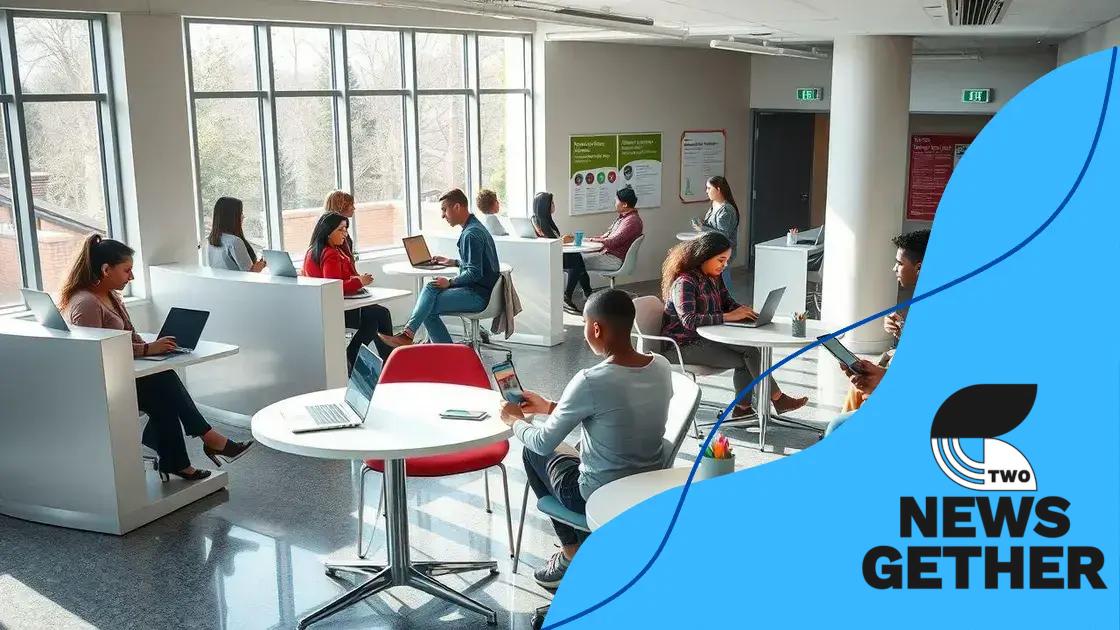How universities are adapting to the post-pandemic learning environment

Universities are adapting to the post-pandemic learning environment by embracing hybrid learning models, enhancing technology in the classroom, innovating student support services, and building strong remote connections to foster student engagement and success.
How universities are adapting to the post-pandemic learning environment has become a hot topic as schools rethink strategies to engage students. What has changed, and how are these adaptations impacting learning?
Evolving teaching methods in universities
As the landscape of education shifts, evolving teaching methods in universities are becoming essential. Teachers are adopting new strategies to engage students and enhance learning experiences.
Innovative Approaches to Learning
One major change is the move towards more interactive and participatory methods. Traditional lectures are being replaced or supplemented by:
- Group discussions that foster collaboration.
- Project-based learning that encourages critical thinking.
- Flipped classrooms where students review content at home and engage in hands-on activities in class.
- Utilization of digital tools that support personalized learning.
These methods not only boost student engagement but also cater to different learning styles. For example, some students may excel in collaborative environments, while others may prefer independent work. Adapting to these preferences is crucial for effective teaching.
Leveraging Technology
Technology plays a vital role in changing how teachers deliver content. With the rise of online platforms, universities can now reach students who may have previously faced barriers to education.
By integrating tools like video conferencing, forums, and online quizzes, instructors can create a more flexible and accessible learning experience. This adaptability is key for both in-person and remote learning situations.
Moreover, using data analytics allows educators to track student progress and adjust their teaching strategies to meet diverse needs. For instance, if a significant number of students struggle with a particular concept, instructors can modify their approach or provide additional resources.
The Importance of Real-World Applications
Another significant evolution is the emphasis on real-world applications of knowledge. Higher education is beginning to align more closely with industry requirements. Programs are increasingly incorporating internships, co-op placements, and practical projects that prepare students for their careers.
- Students gain hands-on experience.
- Networking opportunities open doors for future employment.
- Courses are more relevant to job markets.
This not only benefits students but also helps universities stay connected with industry trends, ensuring that their curriculum is up-to-date.
In summary, the teaching methods in universities are rapidly evolving. By embracing innovative approaches, leveraging technology, and emphasizing practical applications, institutions can create a more enriching educational experience for all students.
Embracing hybrid learning models
As education evolves, embracing hybrid learning models has become essential for universities. This approach combines traditional face-to-face teaching with online elements, offering greater flexibility and accessibility for all learners.
Benefits of Hybrid Learning
One key advantage of hybrid learning is the increased engagement it fosters. Students can interact with their peers and instructors in person while also benefiting from online resources and discussions.
- Accessibility: Students can access materials from anywhere, anytime.
- Personalized learning: Individuals can learn at their own pace, revisiting lectures or engaging in discussions online.
- Increased interaction: Class time can be used for hands-on activities and collaborative projects.
- Expanded course offerings: Institutions can provide a wider range of classes to accommodate diverse interests.
This dynamic method not only meets the needs of diverse students but also prepares them for modern workplaces, which often require a blend of in-person and remote collaboration.
Implementing Hybrid Models Effectively
To implement hybrid learning successfully, universities need to consider several important factors. Training instructors to use technology effectively ensures that they can manage both in-person and online components smoothly.
Additionally, adopting user-friendly platforms is crucial. These platforms should allow students to engage with content easily, participate in discussions, and submit assignments without hassle. Incorporating feedback from students can also help improve the experience continuously.
For instance, using interactive tools like virtual classrooms or discussion boards can enhance the learning experience. These technologies allow students to ask questions and receive timely responses, mimicking a traditional classroom setting.
In conclusion, embracing hybrid learning models is a significant step forward for universities. By combining traditional methods with innovative technology, institutions can create an engaging and flexible learning environment that meets the diverse needs of students.
Innovating student support services

Innovating student support services is essential for enhancing the educational experience. As universities adapt to new challenges, effective support can make a significant difference in student success.
Types of Innovative Support Services
Schools are finding creative ways to assist students, both in-person and online. These services are designed to meet diverse needs and help students navigate their academic journeys.
- Academic coaching provides personalized guidance.
- Mental health resources are more accessible than ever.
- Counseling services are integrating virtual options.
- Career services are expanding to include remote internships.
These options not only support academic achievement but also promote overall well-being.Integrating technology has transformed how services are delivered, making them more available and efficient for students.
Utilizing Technology for Better Access
With the rise of digital platforms, universities can offer support services that fit into busy student schedules. Online counseling sessions, for example, allow students to access help without the need to commute.
Many institutions are also utilizing apps that keep students informed about upcoming events, deadlines, and available resources. This ensures that students not only know about services but can easily utilize them.
Additionally, chatbots and virtual assistants can provide instant responses to common questions, guiding students toward the resources they need. These innovations contribute to a more streamlined and user-friendly approach to support.
Fostering Community and Connection
Innovative support services also emphasize community building. Initiatives like peer mentoring programs create connections among students. These programs allow for sharing experiences and fostering a sense of belonging.
Creating online forums or support groups helps students feel less isolated, especially during challenging times. Whether it is for academic help or personal struggles, having a community can enhance the overall experience.
In summary, by innovating student support services, universities can better meet the needs of their students. This focus on accessibility, technology, and community enhances both academic success and personal growth.
Enhancing technology in the classroom
Enhancing technology in the classroom is a crucial step for modern education. It provides new tools and resources that can significantly boost student learning and engagement.
Types of Classroom Technology
Classroom technology comes in many forms, each offering unique benefits. Some popular types include:
- Interactive whiteboards that replace traditional blackboards.
- Tablets and laptops for personalized learning experiences.
- Document cameras for displaying student work and resources.
- Learning management systems that facilitate online assignments and communication.
These tools help make lessons more interactive and fun, allowing students to engage with the material like never before.
Benefits of Technology Integration
Integrating technology into the classroom brings several advantages. It helps create a more engaging environment where students can work at their own pace. For instance, educational software often provides instant feedback, helping students to learn from their mistakes immediately.
Moreover, technology can also connect students with resources outside the classroom. Online platforms grant access to a wealth of information and different perspectives, enriching the learning experience. The ability to collaborate with peers remotely fosters a sense of community, even in virtual settings.
Teachers also benefit from technology; they can track student progress more effectively and tailor lessons to meet individual needs. This enables a more customized approach to teaching, which can lead to better student outcomes.
Challenges and Solutions
While the benefits are clear, there are challenges too. Not all students have equal access to technology, which can create disparities in learning. Schools need to find solutions to ensure everyone can benefit, such as providing loaner devices or developing partnerships with local businesses.
Additionally, educators must receive training to effectively integrate technology into their teaching. Professional development programs can equip teachers with the necessary skills to use these tools effectively. Fostering a mindset of continuous improvement among educators is essential for maximizing the impact of technology.
In summary, enhancing technology in the classroom offers numerous advantages for students and teachers. By embracing these tools, educational institutions can create a more dynamic and inclusive learning environment, preparing students for success in the digital age.
Building community and remote connections
Building community and remote connections is vital in today’s educational environment. As universities adapt to changing circumstances, fostering relationships among students is more important than ever.
Importance of Community in Education
A strong sense of community positively impacts academic success. When students feel connected to their peers and faculty, they are more likely to participate actively in their education. This connection helps students feel valued and supported, even in remote learning settings.
- Enhanced collaboration through group projects.
- Increased motivation to engage with course material.
- Better emotional support through shared experiences.
Social interactions can improve focus and retention of information, creating a more enriching educational journey.
Strategies for Building Connections Online
Creating remote connections involves using technology effectively. Virtual events and online discussions are great ways to bring students together. These platforms can host workshops, guest speakers, and networking events that foster engagement.
Utilizing tools like video conferencing allows for face-to-face interaction, even from a distance. Students can join study groups and participate in interactive sessions that create a community feel. Additionally, social media platforms can facilitate informal interactions, making it easier for students to connect and share ideas.
Mentorship programs also play a critical role in building community. Pairing students with mentors encourages personal growth and provides valuable guidance throughout their academic journey.
Encouraging Peer Support Networks
Establishing peer support networks enhances remote communities. These networks allow students to seek help from each other, share resources, and build friendships. Online forums or discussion boards provide spaces for students to discuss challenges, celebrate achievements, and collaborate on projects.
Furthermore, organizing virtual clubs or interest groups can help students connect around shared passions. These spaces encourage socialization and support, creating a strong sense of belonging among participants. As a result, these networks promote resilience and adaptability, which are essential skills in today’s world.
In summary, building community and remote connections is crucial in the evolving educational landscape. By leveraging technology and fostering collaboration, universities can create supportive environments that enhance student well-being and success.
FAQ – Frequently Asked Questions about Post-Pandemic Learning Adaptations
How can hybrid learning improve student engagement?
Hybrid learning combines in-person and online experiences, allowing students to participate in a way that best suits their learning style.
What technology is being used to enhance classroom learning?
Tools like interactive whiteboards, learning management systems, and online collaboration platforms are being used to improve the learning experience.
How does building a community benefit students in remote learning?
Building a community helps students feel connected and supported, which can enhance motivation and academic success, even when learning online.
What types of support services are available for students?
Many universities offer academic coaching, mental health resources, and virtual counseling to ensure students receive the support they need.






